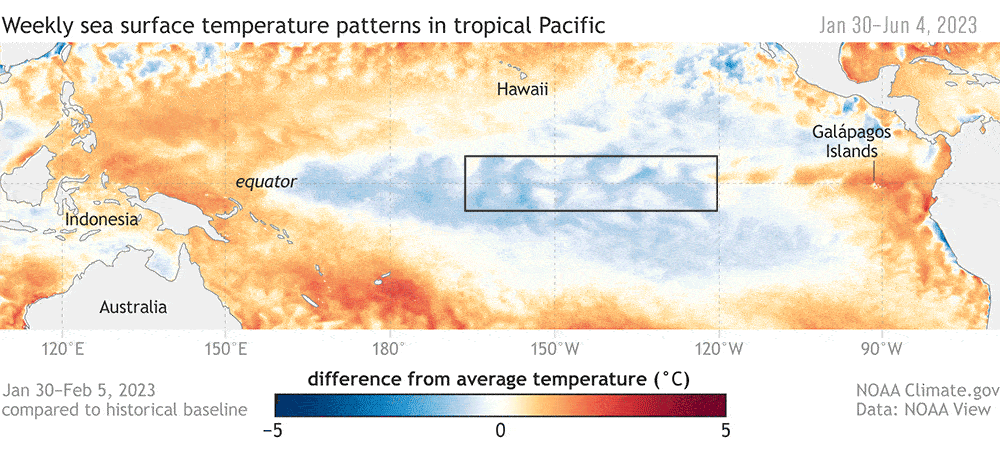
Expected to be moderate-to-strong by late fall/early winter
The expected El Niño has emerged, according to scientists at NOAA’s Climate Prediction Center, a division of the National Weather Service. In the monthly outlook released today, forecasters issued an El Niño Advisory, noting that El Niño conditions are present and are expected to gradually strengthen into the winter.
El Niño is a natural climate phenomenon marked by warmer-than-average sea surface temperatures in the central and eastern Pacific Ocean near the equator, which occurs on average every 2-7 years. El Niño’s impacts on the climate extend far beyond the Pacific Ocean.
”Depending on its strength, El Niño can cause a range of impacts, such as increasing the risk of heavy rainfall and droughts in certain locations around the world. Climate change can exacerbate or mitigate certain impacts related to El Niño. For example, El Niño could lead to new records for temperatures, particularly in areas that already experience above-average temperatures during El Niño.”
– Michelle L’Heureux, climate scientist at the Climate Prediction Center
El Niño’s influence on the U.S. is weak during the summer and more pronounced starting in the late fall through spring. By winter, there is an 84% chance of greater than a moderate strength El Niño, and a 56% chance of a strong El Niño developing. Typically, moderate to strong El Niño conditions during the fall and winter result in wetter-than-average conditions from southern California to along the Gulf Coast and drier-than-average conditions in the Pacific Northwest and Ohio Valley. El Niño winters also bring better chances for warmer-than-average temperatures across the northern tier of the country.
A single El Niño event will not result in all of these impacts, but El Niño increases the odds of them occurring.
The anticipated persistence of El Niño also contributed to the 2023 Atlantic and Eastern Pacific Hurricane Outlooks issued by NOAA last month. El Niño conditions usually help to suppress Atlantic Hurricane activity, while the presence of El Niño typically favors strong hurricane activity in the central and eastern Pacific Basins.
The Climate Prediction Center’s seasonal temperature and precipitation outlooks will continue to take into account current and forecasted El Niño conditions. These seasonal outlooks are updated monthly, with the next update on June 15. The Atlantic Hurricane Season Outlook will be updated in early August.
Scientists have been forecasting the development of El Niño for the last few months and issued the first El Nino Watch on April 13.